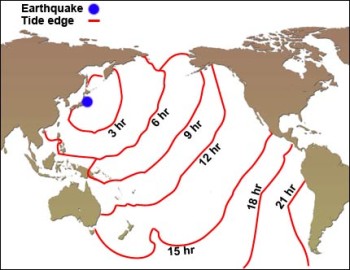
The world watched in horror as a tsunami caused devastation in Japan. A massive earthquake measuring 9.0 on the Richter scale hit the northeastern coastline triggering a 10m tsunami that caused extensive damage. It is the biggest recorded earthquake to hit Japan and tens of thousands of casualties are feared.
What are tsunamis?
Tsunamis are often called tidal waves. But these waves have nothing to do with the tides. They are usually caused by a submarine earthquake occurring less than 50 km below the sea floor, though they can also be caused by undersea volcanic eruptions or landslides.
Though on a potentially devastating scale, these are essentially giant ripples in the sea. The wavelength may be huge - 100 to 200 km, with a wave height of less than a metre, with an interval of between five minutes and an hour between waves. So a ship in the open ocean may not be at all bothered by it.
Tsunami heightens on approach to land
But as the waves approach land, friction slows them down, the wavelength shortens, and the height grows, to perhaps 15 to 30 m, especially in bays and inlets. The front of the first wave may be nearly vertical. There may be three to five major oscillations before the process stops. Tsunamis can be reflected and influenced by the shape of the sea floor, so their effects can vary greatly from place to place.
Sometimes, the first sign to reach land may be not the high wave that follows, but a trough, even exposing the sea floor. In November 1755 on All Saints Day, in Lisbon, Portugal, this happened, and as many curious onlookers rushed onto the floor of the bay to inspect this curious phenomenon, they were drowned by the tidal wave that followed just minutes later. And similar phenomena have been described in this latest disaster.
Previous tsunami disasters
The tsunami that hit south east Asia (11 countries) on December 26 2004 is estimated to have killed 250 000 people. The worst tsunami previously recorded, occurred in 1703 at Awa, Japan, killing 100 000 people. A tsunami in June 1896, hit the coast of Sanriku, Japan, killing and injuring over 30 000 people. The September 1923 major earthquake that struck Tokyo/Yokohama, killing over 134 000 people, also caused a tsunami which killed a further 60 people nearby. The 1960 earthquake on the coast of Chile, killed some 5 700, but also created tsunami-like seismic sea-waves which caused deaths and damage in Hawaii, Japan, and the Pacific coast of the United States.
While this recent event may represent the largest catastrophe affecting many different countries, one must remember catastrophes such as the July 1976 earthquake in T'ang-shan, China, east of Peking, which killed over 240,000 people.
The March 1964 Alaska earthquake was nearly as severe (8.5 Richter scale), but due to the low population density, only killed 131 people, though causing major property damage. It caused major re-shaping and tilting of the landmass in the area, and tsunamis caused extensive coastal damage, as far away as California.
The best organised region in the world, from the point of view of identifying, predicting and tracking such disasters, is that involving the Pacific Rim, with cooperation between Japan, Siberia, Alaska and Hawaii, with the SSWWS (Seismic Sea Wave Warning System) based in Honolulu, which coordinated data and issues warnings. This is the region most affected. Hawaii, for instance, has been struck by 40 tsunamis since 1819.
Related phenomena
A related phenomenon we haven't heard of this time, are called Seiches, which are oscillations of water in lakes or nearly landlocked bays, caused by tsunamis or earthquakes, and which may last for hours or even a couple of days. After the great Lisbon earthquake of 1755, oscillations were noticed in lakes and canals as far away as Scotland and Sweden. Similar vibrations were noticed in Texas around 40 minutes after the 1964 Alaska earthquake.
Another sinister possibility is sometimes called a seaquake, in which heavy waves from an earthquake are refracted through the seafloor, travelling at the speed of sound in water (around 1.5 km per second); which can strike a ship with such force as to give the impression that it has run into a solid object.
The story of the lost civilization of Atlantis is merely a legend, though many writers have insisted they have identified it, in America, Scandinavia, and the Canary Islands. The most credible identification would be with the major volcanic eruption on the island of Thera, in the Mediterranean, around 1500 B.C., which was accompanied by a series of earthquakes and tsunamis, which destroyed much of the civilisation of ancient Crete.
(Professor M.A. Simpson, Health24, updated March 2011)
(Pic: iStock. Graphic by Denzil Daniels, Health24)
Read more:
Surviving disasters
Health24's Environmental Disaster Centre




 Publications
Publications
 Partners
Partners















